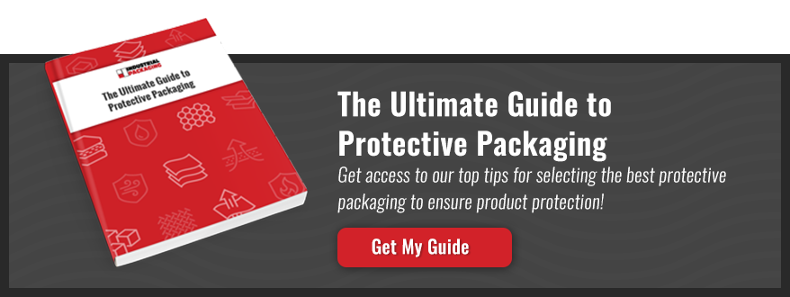What Are The Different Types Of Flexible Pouches?
You may be familiar with stand up pouches, but truth be told, they are only one of several different types of flexible pouches. Other examples you might not be as familiar with include gusseted pouches (side gusset and bottom gusset), three side seal pouches, pillow pouches, and so on.
Here at Industrial Packaging, we have been selling flexible packaging materials for many years. We're often asked about what each type of pouch has to offer and why to choose one kind of pouch over another. In this article, we will explore the different types of flexible pouches and help you find the right solution for your needs.
What Are Flexible Pouches?
Flexible pouches are single-use bags commonly made of metal foil, plastic, and occasionally, paper. They are used for packaging everything from snack foods to industrial liquids and are commonly found on supermarket shelves across the globe.
Flexible pouches have become extremely popular over the past few years for food packaging. This is beacuse many of them are resealable, environmentally friendly, and cheaper than alternatives like glass, metal, and cardboard containers.
They are used for packaging everything from granola to energy drinks. Their widespread adoption is linked to the fact that they have a much lower carbon footprint than the alternative packaging materials mentioned above and take up much less space in our landfills.
Most recently, they have been widely adopted in the industrial hemp and legal cannabis markets as commonly used packaging supplies for whole flower cannabis and hemp products.
What Are The Different Types Of Flexible Pouches?
- Stand Up Pouches
- Gusseted Pouches (Side Gusset And Bottom Gusset)
- Pillow Pouches
- 3 Side Seal Pouches
- Liquid Pouch Packaging
Many people are familiar with stand up pouches as they are one of the most popular types of flexible pouches on the market today. But they might not be the best product for your packaging needs. We will dive into the different types of flexible packaging pouches currently available, and explain why some models are better suited than others for specific products.
Stand Up Pouches
Stand up pouches are perhaps the most well known and accessible version of flexible pouches. They are called stand up pouches because, well, they stand up! You’ve probably seen these in the grocery store with resealable granola pouches. 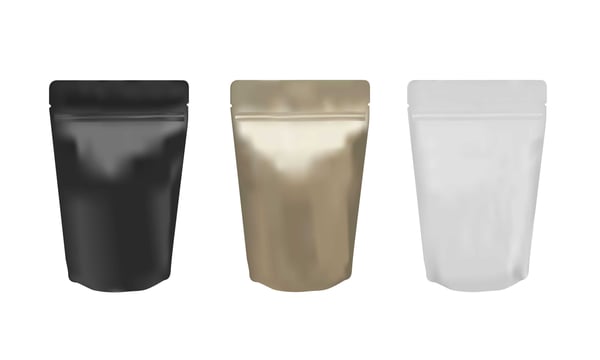
The tops usually have a "tear-off" tab that, once removed, allows the package to be sealed and then reopened as needed until the product inside has been depleted.
They also usually have a plastic zip-lock below the tear-off tab, which allows for them to be resealed. Stand up pouches made for liquid packaging applications often feature a plastic cap similar to those found on plastic water bottles (more on that later).
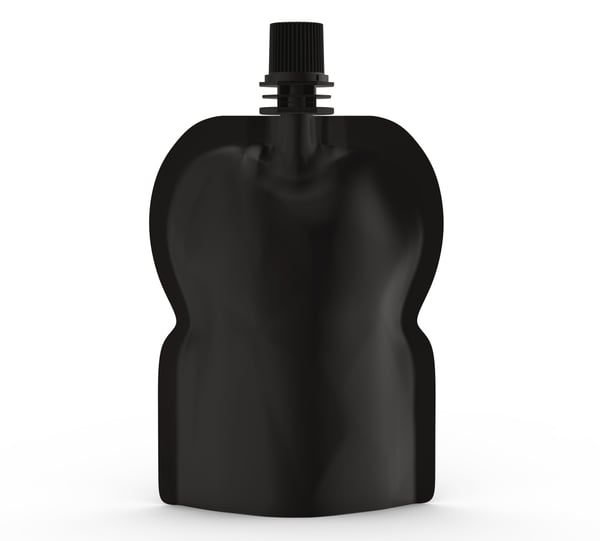
What makes them "stand up" is an oval-shaped pocket underneath the bottom of the pouch, which allows for the circumference of the oval to act as a base for the bag. Placing the pouch upon a flat surface results in the pouch standing up.
You can find various items packaged in these pouches such as crackers, chips, cookies, baking powders, pretzels, beef jerky, and many other types of food products.
Stand up pouches may be right for you if you are looking for an affordable and environmentally friendly flexible packaging supply. Furthermore, stand up pouches can be customized and printed with full color, edge to edge graphics and imagery that make them very appealing to consumers.
Are you utilizing flexible protective packaging or thinking about using it for your product lines?
Download our free eGuide to Protective Packaging!
Gusseted Pouches
Gusseted pouches are a variation on stand up pouches. With gusseted pouches, there are semi-oval shaped indents on both sides of the pouch which make for a square or rectangle base.
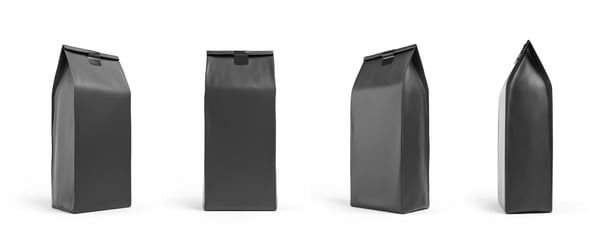
This allows them to stand up but in a different fashion from traditional stand-up pouches. The tops of the bags often feature a different kind of resealability.
The tops of the pouches are pushed together and then folded down repeatedly until they reach a section with a glue or other sticky material. The fold sticks to the glue and is sealed until your customer opens the pouch.
When the seal is broken and then unfolded, two tabs can be revealed from the sides at the top of the pouch. The unsealed pouch can then be closed, folded back down, and the two tabs can be pushed over the fold to keep the bag sealed until next use.
Some gusseted pouches feature package valves, which are small circular valves made of plastic. These valves allow oxygen and scent to escape the pouch. This prevents air from getting inside from the outside of the pouch. The point of these valves is two-fold.
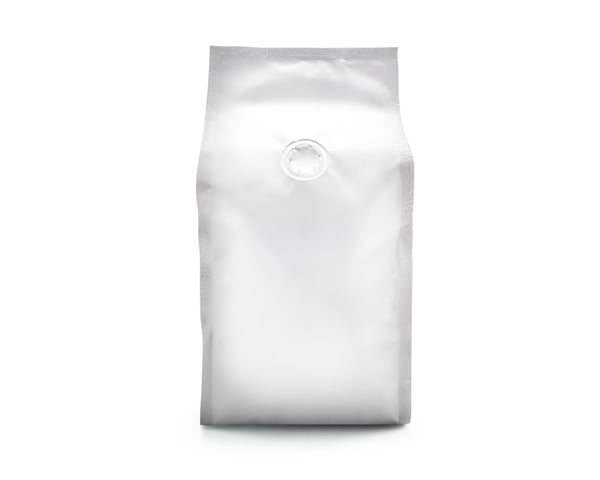
One, they ensure that the product inside stays fresh. Secondly, they allow for the scent of the product to be experienced by the consumer. Valved gusseted pouches are most commonly used for packaging coffee but are used for other food packaging applications as well.
Gusseted pouches may be a good fit for you if you are packaging a food item or other product that needs to maintain freshness for longer periods of time. Additionally, valved gusseted pouches are a perfect fit for coffee and other types of products that emit a pleasant scent. The valve will ensure that no oxygen enters the bag to preserve freshness while also attracting consumers with the sent of the product within.
Side Gusseted Pouches VS Bottom Gusseted Pouches
Now when it comes to gusseted pouches, there are two main varieties: side gusseted pouches and bottom gusseted pouches. Side gusseted pouches are the ones usually used for coffee and feature the two flat panels on the front and back with the gussets on the left and right side.
The flat panels on the back and front are where the central imagery, branding, and graphic art aesthetics are focused. The front panel is pointing outward on store shelves, facing anybody walking down the aisle. The back panel usually has text explaining the product, nutritional information, and consistent branding to the front of the pouch.
Bottom gusseted pouches are generally larger than side gusseted pouches and can contain larger amounts of product. Bottom gusseted pouches have more shape and size possibilities than side gusseted pouches because they only have one gusset (on the bottom). This allows for the overall shape to be more fluid in design.
Pillow Pouches
Pillow pouches are one of the longest-running types of flexible pouches on the market. For decades products like potato chips, crackers, individual snack packs, single-serving coffee, and other types of smaller servings of food have been packaged this way.
As one of the most affordable and straightforward pouches currently available, they are popular with many companies in the food industry, particularly those businesses that package snack foods such as chips and candy.
Their longevity in the market has made them exceptionally well known in households throughout the world. Pillow pouches come in resealable and non-resealable varieties.
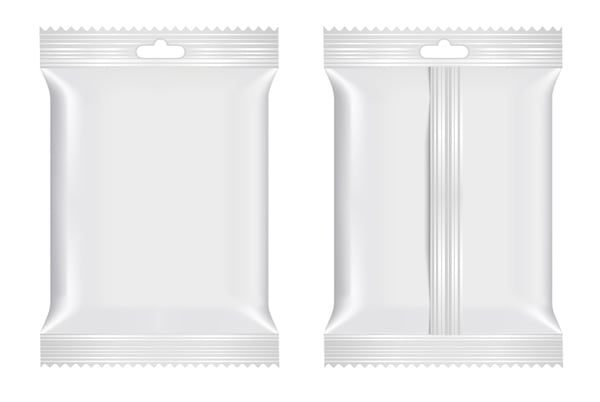
They feature heat seals at the top and bottom of the pouch. There is also a center seal that runs up the back of the pillow that has a short flap running vertically from the top to bottom seal. Some pillow pouches have a small die-cut oval shape on the top seal. This allows them to hang on metal pegs in a retail setting.
Consumers will often open the pouch by pulling the two flat sides of the pouch in opposite directions. This usually results in the top seal opening for easy snacking or consumption of the product inside. Sometimes this method produces jagged tears or complications in opening the pouch, which may induce wrap rage. Some consumers choose to cut the top seal off as that generally results in a smooth opening.
Pillow pouches may be a good choice for your packaging needs if you are looking for a simple, proven effective, environmentally friendly packaging solution that is both affordable and well recognized by consumers in the marketplace.
3 Side Seal Pouches
Three side seal pouches are made of two pieces of metal foil or one side being a metal foil and the other clear plastic. This style of pouch is sometimes made of paper as well (see below). The two sheets of material are placed on top of each other and then heat-sealed on three sides.
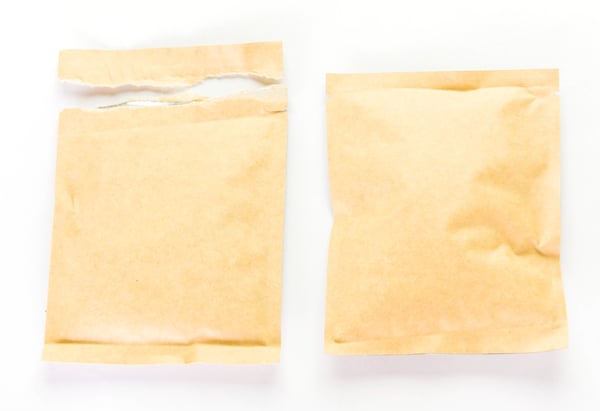
The top or bottom of the pouch is left open for filling. Afterward, the pouch is completed with a tear-away lid. This makes it easy for the consumer to open the pouch after purchase.
Three side seal pouches are often used for packaging beef jerky, spices, pet food, cannabis and other edible and non-edible products. Three side seal pouches can also be equipped with hang holes and resealable zippers similar to those found on stand up pouches.
Three side seal pouches may be a good option for people looking for a sturdy pouch that allows for the consumer to see the product inside (if it has the clear window) and simple opening capabilities via a tear away lid.
Liquid Pouch Packaging
Liquid pouches include several different variations made specifically for liquid packaging applications. They can be stand up, three side seal, burst, or dual component pouches.
Burst pouches are usually 100% clear pouches used for containing industrial, non-edible liquids and powders. Dual component pouches are burst pouches that contain two or more connected and seal separated pouches. These contain multiple industrial liquids or powders that are needed in tandem for specific applications.
Liquid pouches are commonly used for packaging hot sauce, ketchup, bbq sauce, mustard, relish, energy drinks, nut butter, liquid dietary supplements, industrial liquids, and many other types of liquid products.
Liquid pouches are an excellent choice for packaging liquids. They offer a lower cost and carbon footprint than traditional glass and rigid plastic liquid containers. In addition to being environmentally friendly, they can be printed edge to edge with eye catching branding elements that are sure to grab the consumer's attention.
How To Choose The Right Flexible Pouch Packaging
When starting your journey to buy flexible pouches, you need to figure out which type of flexible pouches are right for your products and business. In order to choose the right type of packaging, you need to review the information above and consider the reasons that each pouch would be a good fit for the different types of products mentioned.
In order to choose the right type of packaging you will need to consider several variables including but not limited to your budget, current packaging machinery and materials and your products weight, size, width and height.
With this information in hand, you will be able to work with a packaging vendor to help assist you in choosing the right packaging for your needs, budget and packaging line.
It is advised that you review at least 3 or 4 different flexible packaging vendors. Next, request information from each of them about flexible pouches and the different types they offer. You should have a conversation with a packaging expert from each vendor.
Request in-depth blog posts, white papers, and other educational items based upon the type of pouches you are interested in.
Ask each rep for a free analysis of your packaging line and, if possible, bring in each one to your physical location. Have them analyze your packaging line, materials, and machinery in person so they can get a very clear image of the flexible packaging solution that is right for you.
Next, you will want to request a proposal from each rep and thoroughly dissect and review each proposal with your team and choose which rep you all feel is best suited to meet your needs.
It is recommended to choose a local provider. If that is not possible, be sure to question your preferred vendor on essential topics such as customer service, lead times, shipping, returns, service times, and any other element that is most important to your company.
About Nathan Dube
As the Digital Marketing Specialist at Industrial Packaging, I am honored to create content for such a phenomenal company and work with one of the greatest teams in the Packaging Industry. Whether creating a video, writing blog posts or generating other pieces of content and multimedia, I am always excited to help educate and inspire our prospects and clients to reach their highest potential in regards to their packaging processes and needs.



